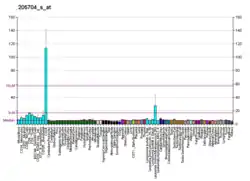ATP6V0A2
V-type proton ATPase 116 kDa subunit a isoform 2 also known as V-ATPase 116 kDa isoform a2 is an enzyme that in humans is encoded by the ATP6V0A2 gene.[5][6][7]
Function
V-ATPase 116 kDa isoform a2 is a subunit of the vacuolar ATPase (v-ATPase), an heteromultimeric enzyme that is present in intracellular vesicles and in the plasma membrane of specialized cells, and which is essential for the acidification of diverse cellular components. V-ATPase consists of a membrane peripheral V(1) domain for ATP hydrolysis, and an integral membrane V(0) domain for proton translocation. The subunit encoded by this gene is a component of the V(0) domain.[7]
Clinical significance
Mutations in this gene are a cause of both cutis laxa type II and wrinkly skin syndrome.[7]
References
- GRCh38: Ensembl release 89: ENSG00000185344 - Ensembl, May 2017
- GRCm38: Ensembl release 89: ENSMUSG00000038023 - Ensembl, May 2017
- "Human PubMed Reference:". National Center for Biotechnology Information, U.S. National Library of Medicine.
- "Mouse PubMed Reference:". National Center for Biotechnology Information, U.S. National Library of Medicine.
- Lee C, Ghoshal K, Beaman KD (Jan 1991). "Cloning of a cDNA for a T cell produced molecule with a putative immune regulatory role". Mol Immunol. 27 (11): 1137–1144. doi:10.1016/0161-5890(90)90102-6. PMID 2247090.
- Kornak U, Reynders E, Dimopoulou A, van Reeuwijk J, Fischer B, Rajab A, Budde B, Nurnberg P, Foulquier F, Lefeber D, Urban Z, Gruenewald S, Annaert W, Brunner HG, van Bokhoven H, Wevers R, Morava E, Matthijs G, Van Maldergem L, Mundlos S (Dec 2007). "Impaired glycosylation and cutis laxa caused by mutations in the vesicular H+-ATPase subunit ATP6V0A2". Nat Genet. 40 (1): 32–34. doi:10.1038/ng.2007.45. PMID 18157129. S2CID 23318808.
- "Entrez Gene: ATP6V0A2 ATPase, H+ transporting, lysosomal V0 subunit a2".
Further reading
- Nishi T, Forgac M (2002). "The vacuolar (H+)-ATPases--nature's most versatile proton pumps". Nat. Rev. Mol. Cell Biol. 3 (2): 94–103. doi:10.1038/nrm729. PMID 11836511. S2CID 21122465.
- Kawasaki-Nishi S, Nishi T, Forgac M (2003). "Proton translocation driven by ATP hydrolysis in V-ATPases". FEBS Lett. 545 (1): 76–85. doi:10.1016/S0014-5793(03)00396-X. PMID 12788495. S2CID 10507213.
- Morel N (2004). "Neurotransmitter release: the dark side of the vacuolar-H+ATPase". Biol. Cell. 95 (7): 453–457. doi:10.1016/S0248-4900(03)00075-3. PMID 14597263. S2CID 17519696.
- Strausberg RL, Feingold EA, Grouse LH, et al. (2003). "Generation and initial analysis of more than 15,000 full-length human and mouse cDNA sequences". Proc. Natl. Acad. Sci. U.S.A. 99 (26): 16899–16903. doi:10.1073/pnas.242603899. PMC 139241. PMID 12477932.
- Smith AN, Lovering RC, Futai M, et al. (2003). "Revised nomenclature for mammalian vacuolar-type H+ -ATPase subunit genes". Mol. Cell. 12 (4): 801–803. doi:10.1016/S1097-2765(03)00397-6. PMID 14580332.
- Ota T, Suzuki Y, Nishikawa T, et al. (2004). "Complete sequencing and characterization of 21,243 full-length human cDNAs". Nat. Genet. 36 (1): 40–45. doi:10.1038/ng1285. PMID 14702039.
- Derks R, Beaman K (2005). "Regeneration and tolerance factor modulates the effect of adenosine triphosphate-induced interleukin 1 beta secretion in human macrophages". Hum. Immunol. 65 (7): 676–682. doi:10.1016/j.humimm.2004.04.006. PMID 15301855.
- Derks RA, Beaman KD (2005). "Regeneration and tolerance factor prevents bystander T-cell death associated with human immunodeficiency virus infection". Clin. Diagn. Lab. Immunol. 11 (5): 835–840. doi:10.1128/CDLI.11.5.835-840.2004. PMC 515283. PMID 15358640.
- Lattuada D, Mangioni S, Viganò P, et al. (2005). "The placental immunomodulatory cytokine regeneration and tolerance factor is also expressed by both human cycling and early pregnant endometrium". Am. J. Reprod. Immunol. 52 (3): 224–231. doi:10.1111/j.1600-0897.2004.00210.x. PMID 15373763. S2CID 31733518.
- Hurtado-Lorenzo A, Skinner M, El Annan J, et al. (2006). "V-ATPase interacts with ARNO and Arf6 in early endosomes and regulates the protein degradative pathway". Nat. Cell Biol. 8 (2): 124–136. doi:10.1038/ncb1348. PMID 16415858. S2CID 23246611.
- Olsen JV, Blagoev B, Gnad F, et al. (2006). "Global, in vivo, and site-specific phosphorylation dynamics in signaling networks". Cell. 127 (3): 635–648. doi:10.1016/j.cell.2006.09.026. PMID 17081983. S2CID 7827573.
- Ntrivalas E, Gilman-Sachs A, Kwak-Kim J, Beaman K (2007). "The N-terminus domain of the a2 isoform of vacuolar ATPase can regulate interleukin-1beta production from mononuclear cells in co-culture with JEG-3 choriocarcinoma cells". Am. J. Reprod. Immunol. 57 (3): 201–209. doi:10.1111/j.1600-0897.2006.00463.x. PMID 17295899. S2CID 37937722.
External links
- GeneReviews/NCBI/NIH/UW entry on ATP6V0A2-Related Autosomal Recessive Cutis Laxa
- OMIM entries on ATP6V0A2-Related Autosomal Recessive Cutis Laxa
- Human ATP6V0A2 genome location and ATP6V0A2 gene details page in the UCSC Genome Browser.
This article incorporates text from the United States National Library of Medicine, which is in the public domain.




